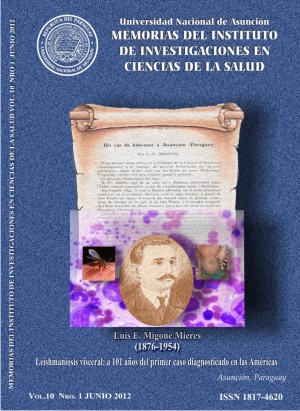Características clínico-demográficas y tipificación del virus de papiloma humano en mujeres paraguayas con citologías negativas para lesión escamosa intraepitelial
Palabras clave:
tipificación, virus de papiloma humano, citología negativa, características clínico-demográficasResumen
Paraguay posee una alta tasa de incidencia de cáncer de cuello uterino de 35/100.0000 mujeres en el año 2008 y el virus de papiloma humano (HPV) es su agente causal. La planificación de medidas de prevención puede ser beneficiada con conocimientos sobre los tipos virales, por ello, el objetivo de este estudio fue determinar características clínico-demográficas y los tipos de HPV presentes en mujeres con citología negativa para lesión escamosa intraepitelial. Estudio de corte transverso con componente analítico en 207 mujeres con citología negativa para lesión escamosa intraepitelial provenientes de centros de salud de Asunción. La tipificación fue realizada por reacción en cadena de la polimerasa utilizando cebadores MY09/11 y GP5/GP6, seguida de polimorfismo de longitud de fragmentos de restricción e hibridación lineal reversa, respectivamente. La asociación entre HPV y las características clínico-demográficas fue determinada por análisis de Chi cuadrado (EpiInfo versión 3,2). Se detectó alta frecuencia de HPV (21%), siendo el tipo predominante HPV 16 (4,3%) seguido de HPV 58/31 (2,4% cada uno). Se observó asociación entre la presencia de HPV y la edad (p=0,0002), detectándose mayor frecuencia de HPV en mujeres menores a 30 años, la cual, disminuyó al aumentar la edad, presentando un ligero aumento en mujeres de 60 años o más. En conclusión, los datos muestran una alta frecuencia de HPV y HPV 16 en mujeres menores a 30 años con citología negativa y sugieren la necesidad de realizar control posteriormente, a fin de identificar las infecciones persistentes que podrían causar lesión de cuello uterino.
Descargas
Citas
Bosch FX, Lorincz A, Munoz N, Meijer CJ, Shah KV. The causal relation between human papillomavirus and cervical cancer. J Clin Pathol. 2002; 55(4):244-65.
Muñoz N, Bosch FX, de Sanjose S, Herrero R, Castellsague X, Shah KV, et al. International Agency for Research on Cancer Multicenter Cervical Cancer Study Group. Epidemiologic classification of human papillomavirus types associated with cervical cancer. N Engl J Med. 2003; 348(6):518-27.
de Sanjose S, Quint WG, Alemany L, Geraets DT, Klaustermeier JE, Lloveras B, et al. Human papillomavirus genotype attribution in invasive cervical cancer: a retrospective cross-sectional worldwide study. Lancet Oncol. 2010; 11(11):1048-56.
Bosch FX, Burchell AN, Schiffman M, Giuliano AR, de Sanjose S, Bruni L, et al. Epidemiology and natural history of human papillomavirus infections and type-specific implications in cervical neoplasia. Vaccine. 2008;26 (Suppl 10): K1-16.
Smith JS, Green J, Berrington de Gonzalez A, Appleby P, Peto J, Plummer M, et al. Cervical cancer and use of hormonal contraceptives: a systematic review. Lancet; 361(9364):1159-67.
International Collaboration of Epidemiological Studies of Cervical Cancer. Carcinoma of the cervix and tobacco smoking: Collaborative reanalysis of individual data on 13 541 women with carcinoma of the cervix and 23 017 women without carcinoma of the cervix from 23 epidemiological studies. Int J Cancer. 2006; 118(6):1481–95.
International Collaboration of Epidemiological Studies of Cervical Cancer. Cervical carcinoma and reproductive factors: collaborative reanalysis of individual data on 16 563 women with cervical carcinoma and 33,542 women without cervical carcinoma from 25 epidemiological studies. Int J Cancer. 2006; 119: 1108–24.
Sherpa AT, Clifford GM, Vaccarella S, Shrestha S, Nygård M, Karki BS, et al. Human papillomavirus infection in women with and without cervical cancer in Nepal. Cancer Causes Control. 2010; 21(3):323-30.
Ferlay J, Shin HR, Bray F, Forman D, Mathers C, Parkin DM. Estimates of worldwide burden of cancer in 2008: GLOBOCAN 2008. Int J Cancer. 2010; 127(12):2893-917.
Rolón PA, Smith JS, Muñoz N, Klug SJ, Herrero R, Bosch X, et al. Human papillomavirus infection and invasive cervical cancer in Paraguay. Int J Cancer 2000; 85:486–91.
Mendoza Torres L, Páez M, Insaurralde A, Rodriguez MI, Castro A, Kasamatsu E. Detection of high risk human papillomavirus cervical infections by the hybrid capture in Asunción, Paraguay. Braz J Infect Dis. 2009 ; 13(3): 203-6.
Mendoza LP, Arbiza J, Paez M, Kasamatsu E, Castro A, Giménez G, et al. Distribution of human papillomavirus genotypes in Paraguayan women according to the severity of the cervical lesion. J Med Virol. 2011; 83(8): 1351-7.
Saiki RK, Gelfand DH, Stoffel S, Scharf SJ, Higuchi R, Horn GT, et al. Primer-directed enzymatic amplification of DNA with a thermostable DNA polymerase. Science 1988;239:487–91.
Manos MM, Ting Y, Wright DK, Lewis AJ, Broker TR, Wolinsky SM. The use of polymerase chain reaction amplification of DNA with a thermostable DNA polymerase. Cancer Cell 1989; 7:209–14.
Sanguinetti CJ, Dias Neto E, Simpson AJ. Rapid silver staining and recovery of PCR products separated on polyacrylamide gels. Biotechniques. 1994;17(5):914-21.
Bernard HU, Chan SY, Manos MM, Ong CK, Villa LL, Delius H, et al. Identification and assessment of known and novel human papillomavirus by polymerase chain reaction amplification, restriction fragment lengh polymorphisms, nucleotide sequence and phylogenetic algorithms. J Infect Dis. 1994;170:1077–85.
ARC Working Group on the Evaluation of Carcinogenic Risks to Humans.International Agency for Research on Cancer. Human Papillomaviruses. Lyon, France : WHO; 2007. ARC Monographs on the Evaluation of Carcinogenic Risks to Humans. Vol. 90.
Jacobs MV, de Roda Husman AM, Van den Brule AJ, Snijders PJ, Meijer CJ, Walboomers JM. Group-specific differentiations between high, and low-risk human papillomavirus genotypes by general primer-mediated PCR and two cocktails of oligonucleotides probes. J Clin Microbiol. 1995; 33: 901-5.
Van Den Brule AJ, Pol R, Fransen-Daalmeijer N, Schouls LM, Meijer CJ, Snijders PJ. GP5þ/6þ PCR followed by reverse line blot analysis enables rapid and high-throughput identification of human papillomavirus genotypes. J Clin Microbiol 2002; 40:779–87.
Franco EL, Villa LL, Sobrinho J, Prado JM, Rousseau MC, Désy M, et al. Epidemiology of acquisition and clearance of cervical human papillomavirus infection in women from a high-risk area for cervical cancer. J. Infect Dis. 1999;180(5): 1415-23.
Burchell AN, Winer RL, de Sanjose S, Franco EL. Chapter 6: Epidemiology and transmission dynamics of genital HPV infection. Vaccine 2006; 24(Suppl.3):S52–61.
de Sanjosé S, Diaz M, Castellsagué X, Clifford G, Bruni L, Muñoz N, et al. Worldwide prevalence and genotype distribution of cervical human papillomavirus DNA in women with normal cytology: a meta-analysis. Lancet Infect Dis. 2007; 7(7):453-9.
Ripabelli G, Grasso GM, Del Riccio I, Tamburro M, Sammarco ML. Prevalence and genotype identification of human papillomavirus in women undergoing voluntary cervical cancer screening in Molise, Central Italy. Cancer Epidemiol. 2010; 34(2): 162-7.
Lewis, MJ. A situational analysis of cervical cancer in Latin America and the Caribbean. Washington, D.C : PAHO; 2004.
Almonte M, Albero G, Molano M, Carcamo C, García PJ, Pérez G. Risk factors for human papillomavirus exposure and co-factors for cervical cancer in Latin America and the Caribbean. Vaccine. 2008; 26( Suppl 11): L16-36.
Castellsagué X. Natural history and epidemiology of HPV infection and cervical cancer. Gynecol Oncol. 2008; 110(3 Suppl 2):S4-7.
Muñoz N, Méndez F, Posso H, Molano M, Van Den Brule AJ, Ronderos M, et at. Incidence, duration, and determinants of cervical human papillomavirus infection in a cohort of Colombian women with normal cytological results. J Infect Dis. 2004;190(12):2077-87.
Bogaards JA, Xiridou M, Coupé VM, Meijer CJ, Wallinga J, Berkhof J. Model-based estimation of viral transmissibility and infection-induced resistance from the age-dependent prevalence of infection for 14 high-risk types of human papillomavirus. Am J Epidemiol. 2010; 171(7):817-25.
Franceschi S, Herrero R, Clifford GM, Snijders PJ, Arslan A, Anh PT, et al. Variations in the age-specific curves of human papillomavirus prevalence in women worldwide. Int J Cancer. 2006; 119(11):2677-84.
Nielsen A, Kjaer SK, Munk C, Iftner T. Type specific HPV infection and multiple HPV types: prevalence and risk factor profile in nearly 12,000 younger and older Danish women. Sex Transm Dis. 2008; 35:276–82.
Smith JS, Melendy A, Rana RK, Pimenta JM. Age-specific prevalence of infection with human papillomavirus in females: a global review. J Adolesc Health. 2008; 43(4 Suppl):S5-25.
Louie KS, de Sanjose S, Diaz M, Castellsagué X, Herrero R, Meijer CJ, et al. International Agency for Research on Cancer Multicenter Cervical Cancer Study Group. Early age at first sexual intercourse and early pregnancy are risk factors for cervical cancer in developing countries. Br J Cancer. 2009; 100(7):1191-7.














